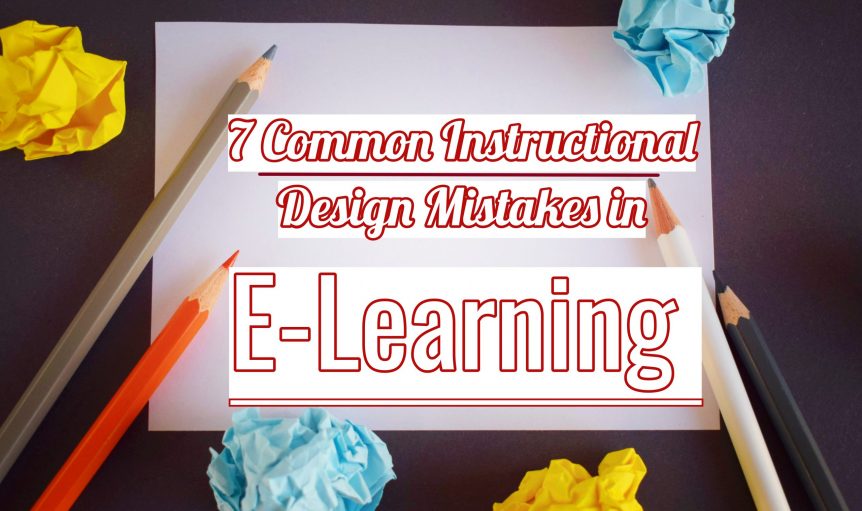7 Common Instructional Design Mistakes in E-Learning
Do you have e-learning courses that are not delivering the results you need? Even training courses that have excellent content can miss the mark because of one of the most important parts of e-learning development – instructional design.
Instructional design is a large and complex topic, but at its core, it is about making e-learning courses as effective as possible. Instructional design is about helping learners acquire the skills and knowledge they need.
There is no one-size-fits-all solution to instructional design, so a custom approach is always required. However, there are common instructional design mistakes that are often made. These mistakes could be the reason for your underperforming training courses. Here are seven of the most often seen.
- Not Focusing on the Learner
E-learning courses and content can be structured in a range of different ways. For example, they can be focused purely on the content, or they can be shaped by how those developing the content understand the topic. Both these examples, however, are not focused enough on the learner.
The best approach to designing an e-learning course is to make the learner the number one priority throughout the process, constantly asking if what is being done will help them learn.
Some tell-tale signs of a lack of focus on the learner include e-learning courses that contain a lot of jargon or where there is an assumption that learners have a greater understanding of certain topic areas than they actually do.
- Information Overload
The human brain can process a limited amount of information at any one time. By providing too much information at once, you are not giving the learner time to get a proper understanding and then commit what they have learned to memory.
A good instructional designer will take this into account when creating a new e-learning course, including by ensuring the course is well-structured with plenty of sections, sub-sections, reviews, and quizzes. These features allow learners to go through the content section by section, reviewing anything they need to, and then checking their knowledge before moving on.
- Poorly Structured Navigation
The biggest goal with navigation in an e-learning course is that it shouldn’t get in the way. Examples of navigation that get in the way include where the learner has to figure out what to do next or pathways that bring learners to a dead end. If the learner has to think “what should I tap/click on next” at any point in the course, the navigation is not as optimised as it could be. Including tips or instructions to help learners as they progress through the course can help, but the need for tips or instructions is also an indicator the navigation could be improved.
The structure of e-learning course navigation should be intuitive, and it should be checked to ensure it doesn’t lead to dead ends or circular routes. The design of links and buttons is also important.
- Lack of Variety
Even the best content can become monotonous for learners if it is presented in the same way screen after screen after screen.
Variety is key in e-learning course design, but it is not just about making the course look good, or even to keep the attention of learners. For an instructional design professional, using a variety of media and content types is about presenting each specific piece of information in a way that helps people learn. Sometimes, this will be a video, for example, while at other times it could be an image or text.
- Including Too Much Content that Lacks Relevancy
There is sometimes a temptation to add content to an e-learning course in an attempt to make it more attractive or engage learners. Examples include quirky headings that are not descriptive, or stock images that don’t contribute anything to the learning experience.
This type of irrelevant content can have a place, e.g., it’s not normally necessary to completely remove or avoid all stock images. The problem arises when you have too much of it, as too much irrelevant content can break the connection you are trying to make between learners and the content.
- Ordering Information Without Priority
The main focus of a section or sub-section should be the most important piece of information. It should usually be at the start of the section, too, rather than buried further into the content.
With an e-learning course, you should think of it as a news story rather than a thriller movie. In a thriller movie, suspense can be built by holding back key pieces of information from the viewer, enhancing the experience. In a news story, however, journalists strive to include the most important information in the first sentence or paragraph.
The latter is the approach that you should take with e-learning courses – prioritising the most important bits of information.
- Too Much Text at Once
Large blocks of text can be very off-putting for learners. It feels like work having to read through it, and it can be difficult to stay engaged when reading for a long period of time, particularly on a topic area that you are just learning.
So, large blocks of text should be broken up with shorter paragraphs, subheadings, lists, images, and videos.
Designing for Learning
Every element of your e-learning course contributes to the learning experience and the results you achieve. This includes everything from the font size you use for text to the navigational elements to how you present the content. In other words, design, structure, and content all matter. Avoiding the above mistakes in instructional design will help make your courses better.
